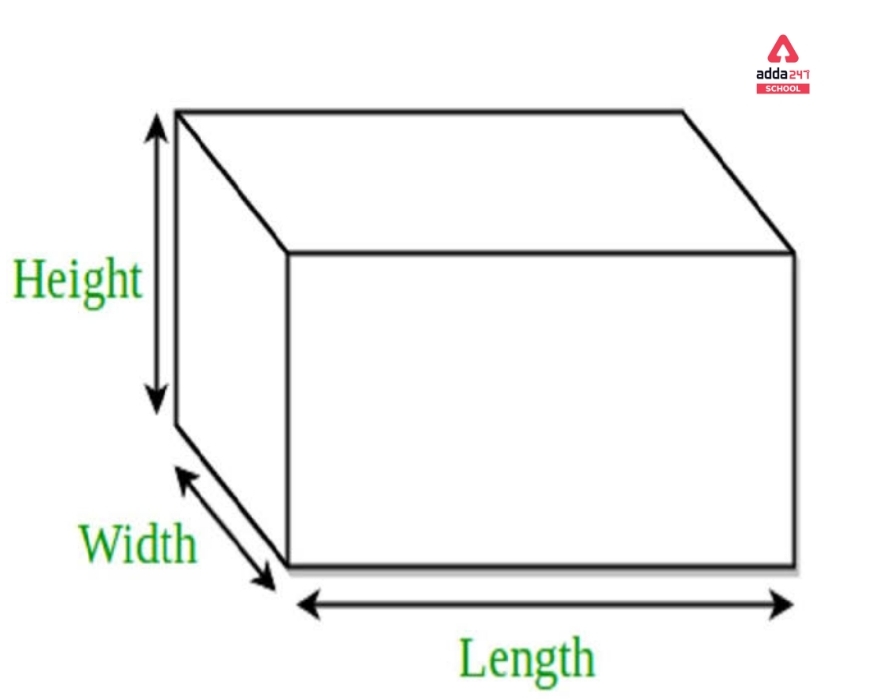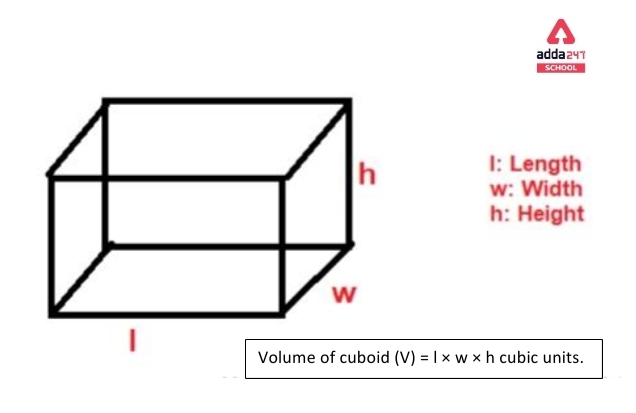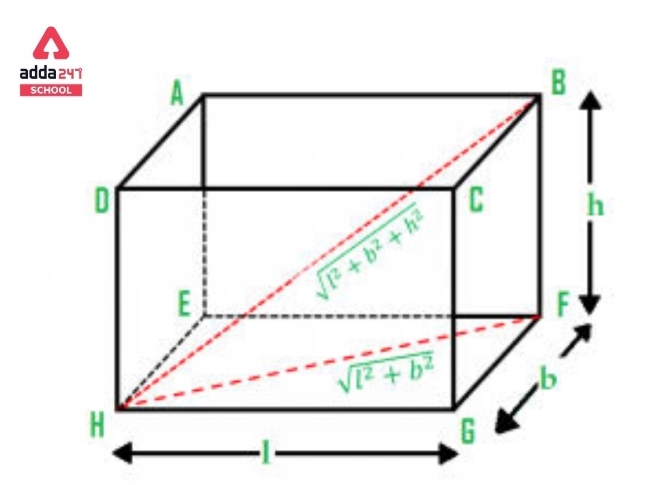Volume of Cuboid
The number of materials that a cuboid can transport or hold is known as the volume of cuboid, and it determines the holding capacity of a cylinder. We can determine volume of cuboid by the Volume of Cuboid formula V= l × b × h . In this article, we will learn about cuboids, their properties, and the Volume of a cuboid with some solved examples. we also know about the properties, surface area, and diagonals of a cuboid.
Cuboid
In geometry, A cuboid is a three-dimensional figure or object that has six rectangular faces, each of which has eight vertices and twelve edges.
Now imagine a shape made by stacking numerous congruent rectangles on top of one another. The resultant formed shape is known as a cuboid. In daily life, we observed different cuboid-shaped objects such as The lunch box, Bricks, Shoebox, Book, Carton boxes, and so on. As a cuboid is a three-dimensional solid object, Thus it has length, Height, and width. Let’s understand those quantities of a cuboid in the following diagram.

Properties of a Cuboid
The properties of a cuboid must be understood before learning about various cuboid quantities. such that we can quickly recognize a cuboid by its characteristics.
The main properties of a cuboid are listed below –
• There are 6 faces, 8 vertices, and 12 edges on a cuboid.
• The edges on either side of each other are parallel
• As a cuboid is a three-dimensional object, it has length, breadth, and height.
• A cuboid has only right angles that are produced at its vertices.
• The shapes of all the faces are rectangles.
• A cuboid has two diagonal lines that can be drawn on each face.
What is the Volume of Cuboid Formula?
A cuboid is a three-dimensional geometric shape with six rectangular faces, where opposite faces are parallel and equal in size. The volume of a cuboid can be calculated using the formula:
Volume = Length × Width × Height
Where:
- Length refers to the length of the cuboid.
- Width refers to the width of the cuboid.
- Height refers to the height of the cuboid.
To calculate the volume of a cuboid, simply multiply its length, width, and height together. This formula works because the volume of a cuboid represents the amount of space enclosed by the three dimensions.
Volume of Cuboid Formula
Earlier we know that volume of cuboid refers to the holding capacity of a cuboid. Basically, the volume of a cuboid refers to the amount that can hold by the cuboid.
The Volume of cuboid formula = Length × breadth × height
If we considered a cuboid having l length,h height, and b breadth. And Volume -V, then
Volume of cuboid (V) = l × b × h cubic units.
Units used to measure the volume of cuboid is –
Cubic Centimeters (cm³), Cubic meters (m³)

Surface Area of a Cuboid
As a Cuboid is a three-dimensional figure, it has two types of surface area –
• Lateral surface area or LSA
• Total surface area or TSA
Lateral surface area of Cuboid Formula
The total area of all faces, excluding the top and bottom faces of a cuboid, is considered as Lateral surface area.
Lateral surface area = Sum of all 4 faces except the top and the top face of the cuboid.
If we took into account a cuboid with l length, h height, and b width. follows.
Lateral surface area (LSA) = 2h(l + b) sq.units
Total Surface Area Cuboid Formula
A cuboid’s surface area is the overall area that it takes up in its shape.
Total surface area (TSA ) equals the sum of the surfaces of all six rectangular faces
If we considered a cuboid having l length,h height, and b breadth. then,
Total surface area (TSA ) =2(lb + bh + hl) sq.units
Perimeter of Cuboid Formula
We know that a cuboid has 8 faces and 12 edges Perimeter is nothing but the sum of the lengths of all the 12 edges.
Taking into account a cuboid with dimensions of l length, h height, and b width. After that,
Perimeter of Cuboid = 4l + 4b + 4h
= 4× (l + b + h)
Perimeter of Cuboid (P) = 4× (l + b + h) units
Diagonals of Cuboid Formula
A line segment that joins two of its opposed vertices and traverses the cuboid’s body, is known as a Diagonal cuboid Since a cuboid is a 3D shape, there are two types of diagonals in it:
• Face Diagonals
• Space Diagonals
Face Diagonals of Cuboid
Face Diagonals are considered as the line segment which is formed by connecting the opposite vertices of a certain cuboid face. Only two diagonals can be formed on each cuboid’s face.
A cuboid has a total of 12 face diagonals since it has 6 faces.
Space Diagonal of Cuboid Formula
A line segment that connects a cuboid’s opposing vertices is known as a space diagonal. The face diagonals have traversed the interior of the cuboid Thus it is possible to draw 4 space diagonals inside of one cuboid.
The Formulas to determine Diagonals of Cuboid
Face Diagonals of cuboid = √(l² + b²) units
Space Diagonals of Cuboid = √(l²+ b²+ h²) units
Whereas a cuboid’s three primary dimensions are its length (l), its width (b), and its height (h),

Volume of Cuboid Formula and Other Related Formula
Here is a list consists all cuboid-related formulas in one place. We looked at a cuboid with the dimensions l length, h height, and b width.
| Cuboid’s Quantities | Formulas |
| Volume of Cuboid | l × b × h cubic units. |
| Total Surface Area (TSA) of Cuboid | 2(lb + bh + hl) sq.units |
| Lateral surface area (LSA) of Cuboid | 2h(l + b) sq.units |
| Perimeter of Cuboid | 4(l + b + h) units |
| Face Diagonals of Cuboid | √(l² + b²) units |
| Space Diagonals of Cuboid | √(l²+ b²+ h²) units |
How to find the Volume of a Cuboid? Formula Based Solved Examples
Q. What is the volume of a cuboid with the dimensions 16 cm long, 12 cm wide, and 10 cm high?
Solution:
The cuboid’s length is 25 cm.
the cuboid’s width is 12 cm
The cuboid’s height is 16 cm.
As we know, the Volume of the cuboid = length× breadth × height.
V = (25 × 12 × 16) cm³
V = 4800 cm³( Answer)
Q. A cubical measures 8 meters long, 3 meters wide, and 10 meters high. Find the cubical’s volume.
Solution:
Length of the cubical – 8 meters.
cubical’s width – 3 meters
Cubical’s height -10 meters
Since the cubical’s volume is determined by its length, width, and height,
So now, volume = 8×3×10 m³
V = 240 m³ . ( Answer)
Q. Determine the total surface area of a cuboid having a length of 10 cm, a height of 12 cm, and a breadth of 8 cm.
As we know Total surface area (TSA ) = The sum of the surfaces of all six rectangular faces
If we considered a cuboid having l length,h height, and b breadth. then,
Total surface area (TSA ) =2(lb + bh + hl) sq.units
In the given problem,
Length (l)= 10 cm , breadth (b) = 8 cm ,height (h)= 12 cm .
Total surface area = 2[ ( 10×8)+(8×12)+(12×10)]
Or,TSA = 2 × (80+ 96+120)
Or, TSA = 592 cm² (Answer)
Related Post:








 HBSE September Result 2025 OUT, Haryana ...
HBSE September Result 2025 OUT, Haryana ...
 CBSE Class 12 Maths Syllabus 2025-26, Do...
CBSE Class 12 Maths Syllabus 2025-26, Do...
 CBSE Class 12 Physics Sample Paper 2025-...
CBSE Class 12 Physics Sample Paper 2025-...

















